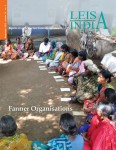/sub-categories/people-and-organisations
People and Organisations
LEISA magazine special issues in Hindi, Tamil and Telugu - A compilation of selected articles on combating desertification
Posted on 10 Jan, 2013 12:08 PMLow external input and sustainable agriculture (LEISA) India has come up with a collection of alternative ways of combating desertification in the fragile region of the country in its recent issue. The articles are success stories of such intiatives by farmers and NGOs.
Water monitoring challenge in Yamuna basin- Educating communites along the river about the importance of water testing & quality
Posted on 03 Jan, 2013 11:01 PMWater, water everywhere, not a drop to drink! How truly these lines depict the picture of present scenario. There are lots of organizations, people and experts involved in the discussions and making efforts at international level to have safe, sustainable drinking water for all. Yet the efforts are not enough…
Join Matri Sadan in their fight to save the Ganga from indiscriminate mining!
Posted on 02 Jan, 2013 12:11 PM
Living rivers, dying rivers: Stuffed rivers of Vrishabhavathi-Arkavathi from the Cauvery system
Posted on 02 Dec, 2012 08:16 PMIntroduction

Living rivers, dying rivers:Rivers of West Bengal, Orissa & Indus system
Posted on 13 Oct, 2012 11:15 PMWest Bengal rivers

Living rivers, dying rivers: River Godavari
Posted on 04 Aug, 2012 08:52 AMThe lecture dealt with 'Perceptions of a river, life and the idea of floods in politics and commerce', with the metaphor of control over rivers dating back to the times of Sir Arthur Cotton, who built the Dowlaiswaram anicut on the Godavari in 1863.

Rohini Nilekani, Chairperson of Arghyam announces transition in leadership: Jayamala Subramaniam to take over from 1st June, 2012
Posted on 13 Apr, 2012 05:44 PMShe comes to Arghyam with a background in the corporate and not for profit sectors, both in India and abroad. She has a record of achievement in taking initiatives to scale in the financial and education sectors and substantial experience as a coach and mentor.
Living rivers, dying rivers: Rivers in the Western Ghats
Posted on 10 Feb, 2012 04:12 PMRiver stories from Maharashtra: Many morals to learn
Parineeta Dandekar’s presentation began with an account of some statistics related to Maharashtra, the third largest state in India. Regarding the state of water resources in Maharashtra, she noted that of the five river basin systems, 55 percent of the dependable yield is available in the four river basins (Krishna, Godavari, Tapi and Narmada) east of the Western Ghats. These four river basins comprise 92 percent of the cultivable land and more than 60 percent of the population in rural areas. 45 percent of the state's water resources are from west flowing rivers which are mainly monsoon specific rivers emanating from the Western Ghats and draining into the Arabian Sea.
With 1821 large dams and more in the offing, Maharashtra has the maximum dams in the country (35.7%). However, the proportion of gross irrigated area vis a vis the gross cropped area at 17.8 percent is much lower than the national average of 44.6 percent. The contradictions from the state, which is home to the highest number of dams, were discussed. In nearly 70 percent of the state’s villages (around 27,600 villages), water is either not available within 500 metres distance, or within 15 metres below ground level or when available is not potable (World Bank, Promoting Agricultural Growth in Maharashtra, Volume 1, 2003).
Dandekar discussed the World Bank funded Maharashtra Water Sector Improvement Project (MWSIP) initiated in 2005 whose main components were establishment, operationalisation and capacity building of Maharashtra Water Resources Regulatory Authority (MWRRA); establishment of river basin agencies in Maharashtra; and restructuring and capacity building of the Water Resources Department. The MWRRA Act (2005) has been amended, taking out the clause for equitable water distribution, and granting the Cabinet the rights to have the last say about water entitlements. This has led to a diversion of water for irrigation from the vulnerable, suicide-prone Vidarbha region to thermal power plants. According to Prayas, “entitlements of more than 1500 MCM have been changed from agriculture to industries and cities”.


